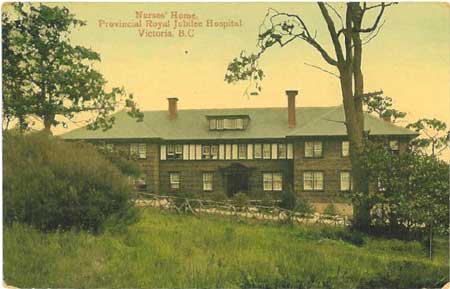One day in 1858 a sick miner was dumped by his friends in the garden of the Christ Church cathedral rectory, with the men evidently believing that the Rev Edward Cridge could heal bodies as well as souls. This incident is quite well documented and it led to the founding of what would eventually become the Royal Jubilee Hospital.
Cridge wasted no time in organizing community support for a cottage hospital for men, in a small rented building at Yates and Broad Sts. This men’s infirmary later moved to the Songhees Reserve area in Victoria West, with a larger building named the Royal Infirmary.
Mrs Edward Cridge and Mrs Thomas Harris (wife of Victoria’s first mayor) were, at the same time, campaigning vigorously for a women’s infirmary. They were offered a ward at the Royal but held out for a new building. In 1864, the cornerstone of a substantial building was laid, at the head of Pandora Av where the First Church of Christ Scientist (1511 Chambers St, Fernwood) now stands.
Eight years later this women’s infirmary and the Royal Infirmary merged into one hospital in the Pandora building. This was quickly outgrown and Queen Victoria’s jubilee in 1887 became the incentive for a new, larger hospital to serve the rapidly growing city.
Twenty acres of land were purchased for $6,700 from the Finnerty family, who owned a large tract of market gardening and farm land. The new hospital grounds, at the corner of what was then Cadboro Bay (now Fort) and Mount Tolmie (now Richmond) Rds, were quite isolated from the city, with only five houses in the vicinity.
John Teague (North Park History) designed the first building on the hospital grounds, built by contractor Thomas Catterall (Teague’s description ran in the Victoria Daily Colonist of April 24, 1889). It was to accommodate 100 patients and the cost was estimated at $35,000, but ended up at $50,558. Elford (1119 Ormond St, Fernwood) & Smith (Hillside-Quadra History) were the contractors. The cornerstone was laid in April 1889 and a time capsule beneath it contained a plan of the building, some silver currency and an English sovereign. H.R.H. the Duke of Connaught (Queen Victoria’s son) officiated at the opening ceremonies on 21 May 1890 and the new hospital was named the Provincial Royal Jubilee Hospital. It was demolished in 1962, and replaced with a new wing.
There were three wards (male surgical, medical and women’s), an administration block with accommodation for a resident medical officer and a matron, a laboratory, an “accident” ward, a meeting room, a kitchen and storerooms. There was no sewer system in the area at that time and it was another six years before electricity was installed. A school of nursing opened in December 1891 and it trained nurses for over 90 years.
An early photograph shows an imposing stone entrance at the corner of what is now Fort St and Richmond Rd. A picket fence measuring almost a mile surrounded the grounds and was constructed by W.H. (Bill) Handley, who later joined the city police force and eventually became Oak Bay’s first chief of police.
In 1896 the Pemberton Memorial Operating Theatre was built to designs by John Teague and was used until 1925 when the East Wing opened. This wing was designed by P.L. James and K.B. Spurgin and included six operating rooms. The East Wing still stands in 2009. The Pemberton Memorial Chapel by architect J.C.M. Keith was built in 1909.
The Strathcona Ward was added in 1904 and the first children’s ward in 1906, by architects Hooper & Watkins. A first nurses’ residence opened in 1909 and was replaced by Begbie Hall in 1930, designed by C. Elwood Watkins .
Other early additions were a TB ward in 1910 and the first maternity ward in 1916. By the end of the 1930s the complex of buildings was re-named the Royal Jubilee Hospital. Further additions included a major new wing in 1940 designed by C. Elwood Watkins, a maternity wing in 1946 designed by provincial architect Henry Whittaker and built with financial assistance from the Kiwanis Club of Victoria, and conversion of the 1904 Strathcona Ward to a children’s ward in 1948. The latter two were to meet the demands of the post-WWII “baby boom.”
In 1947, the present Memorial Pavilion was constructed as the Department of Veterans Affairs Hospital, designed by architects Mercer & Mercer, constructed by Northern Construction Co and J.W. Stewart Contractors. The present Adanac Services building was designed for the Canadian Red Cross by W.F. Gardiner and built in 1946-47. Both buildings are in Saanich and are registered heritage by that municipality.
Construction following a $105-million expansion plan developed in the mid-1990s was still in progress at time of writing.


Recent Comments